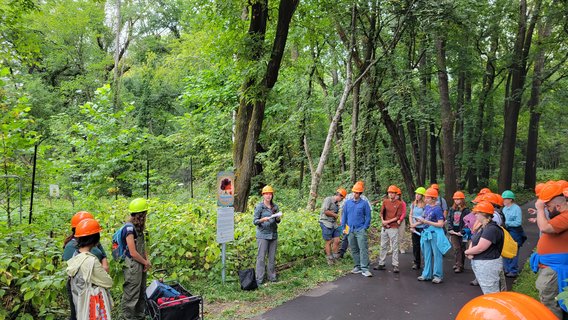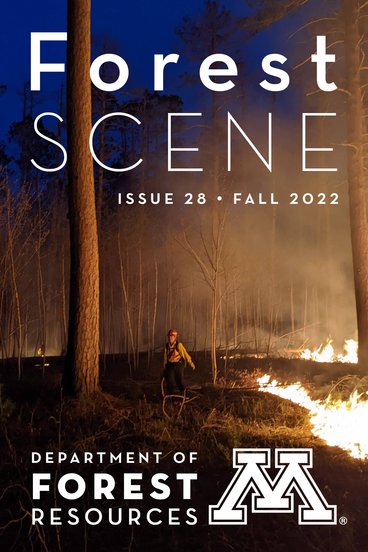Two years ago, hundreds of volunteers helped plant various tree species across 24 plots in Crosby Farm Regional Park, St. Paul, within the Mississippi National River and Recreation Area and on the traditional lands of the Dakota people. They were led by Forest Resources’ Drs. Windmuller-Campione, Montgomery, and many city, county, federal, and non-government organization colleagues. The project is part of the international Adaptive Silviculture for Climate Change project, a network of experimental silvicultural experiments across distinct forest ecosystem types. The installation at Crosby Farm is the first site in an urban setting. Findings from this 20-year study will provide data to support future land management decisions and insights about climate change adaptation, both within the Mississippi National River and Recreation Area and in similar urban forest ecosystems. For example, the study evaluates optimal replacements for ash trees killed by emerald ash borer, resilience potential in changing and warming floodplains, and the best way to plant and protect foundational trees like cottonwood from seedling to mature trees.

An estimated 1 billion ash trees can be found across Minnesota, with a 99% death rate due to the Emerald ash borer, resulting in an unmeasurably devastating canopy loss. While the continued loss of established ash trees at the Crosby Farm site will leave a gap, part of this project involves figuring out the best tree species to replace ash trees in wet forest ecosystems across the Great Lakes Region.
Potential ash tree replacements must be able to thrive as climate change effects transform landscapes and floodplain forests. The study monitors three forest management types – control, resistance, and resilience. The resistance plot is populated by trees that already grow and are represented within the current floodplain ecosystems of Minnesota, Wisconsin, and Iowa. They are more likely to be adapted to be drought or flood-tolerant to prepare the local population for climate-related changes.
Some models predict Minnesota’s climate in 2080 might be like Kansas’s climate. For all tree species, the transition plots are an exercise in gearing up for this potential shift – the plots contain tree species well-adapted to the wet forest of southern climates like Missouri (Zone 6). These trees may better withstand warmer winters and more extreme rain.
Changing water levels can affect management efforts as they did during the drought. Volunteers watered each of the 1,000+ trees twice during the extreme drought of the summer of 2021. Each tree received the exact same amount of water to maintain continuity of research. The team had a big discussion about whether to water the plots or let the trees deal with the extreme drought without intervention. They chose to intervene since they had the resources to water in a consistent manner and could avoid losing trees. They also staked all the oak trees because a few were leaning, for consistency.
Also, climate change will impact foundation species such as cottonwood trees as they help support the building up of a forest. These trees host 84% of bald eagle nests. Yet younger trees are harder to find due to climate change, along with animal and human activities, all factors increasing the risk of losing these nesting areas and tree cover.
In 2022, the Crosby Farm project was enhanced by signage that informs visitors of the three plot types and treatments under investigation. Willard Malebear Jr., a local Indigenous artist, created the artwork and combined Dakota florals with three particularly significant tree species grown in the research plots. The signs center Anishinaabe & Dakota language and were created in partnership with volunteers from the Lower Phalen Creek Project.
Now in year three of the growing season, the tree plot survival rate is more than 75%, an incredible number given the scale and variety of seedlings planted. The residence & resilience treatments have greater than 80% average survival rate, with the transition plots trailing a bit. There was a higher rate of mortality in the first season in the transition treatment, which has leveled out now that the seedlings are more established. River birch trees put on tremendous growth across the treatment plots. Zone 4 Silver Maples excelled, growing from 6-7 feet at planting to about 20 feet. “It’s weird to call these trees seedlings because they’re already casting shade and now, we’re standing under them.” said Auste Eigirdas, graduate student in Dr. Windmuller-Campione’s lab.
Many of the novel species in the transition plots did not do well in the first year, though the team noticed a jump in survival between years one and two, as some trees marked dead in the first year came back and sprouted leaves in the second year. The team is monitoring these “zombie trees” to better understand how these species may be adapted to harsh conditions.
Keep watching the faculty webpages for updates on this research collaboration!

The Forest Scene newsletter is published biannually in the spring and fall, featuring stories and updates from the Department of Forest Resources. Readers can download issue 28 of Forest Scene as an interactive PDF that is fully tagged and compatible with most screen readers, or read the individual stories here in a web-based format.
